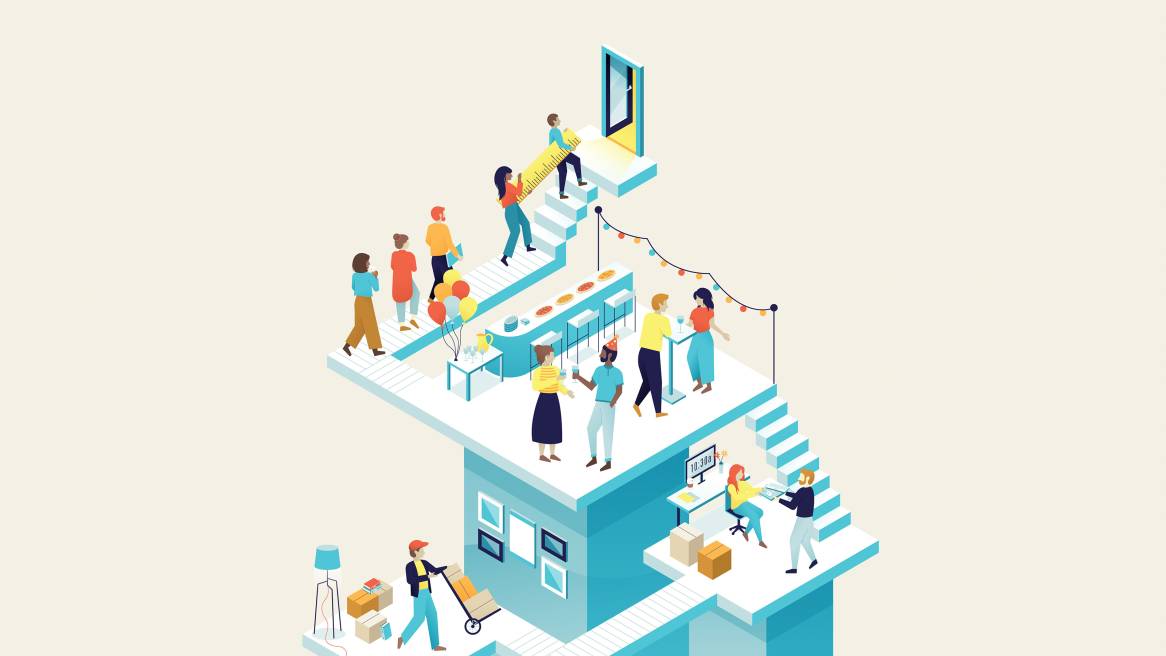Change Management: A Process for Success
Are you making changes to your space and your work experience?
When you’re making changes to your work experience, you’ll need to make an intentional investment in the process for managing the change. A thorough process before, during and after the change will contribute to an experience that is positive for stakeholders and helps them adopt and adapt to the change— a good thing for them as well as toward your desired results.
No two change projects are the same. Some are tweaks; others transformations. Here’s a look at the main steps often involved in bringing significant workplace change to fruition.

Map Your Strategy
You’ve set your vision, confirmed your overall business goals and clarified how the work experience will help you accomplish success. From here, the process continues with the development of a change roadmap, a process detailing all engagement, communication and training activities needed to achieve successful change. This roadmap is the product of a workshop during which key people delve deeply into specifics.
The roadmap should encompass change management that is insync with the project management schedule. You’ll want to focus on each with intentionality. Project management concerns itself with the logistics of the workplace transition efforts.
Change management focuses on the people side, providing the support needed to reduce resistance and gain buy-in. Ideally, change management starts as soon as possible after an organization ponders changes to its space but before making any big decisions.

Appoint a Team
One of your first tasks is to recruit a change management team. It should include leaders, managers and change champions—representatives from key departments who will be instrumental in communicating the case for change throughout your organization. Be sure to place influential people from your Real Estate, IT and HR departments on the change team. Workplace change invariably has a bearing on space, technology and training, so you’ll want these three groups to share ownership in project success.
Many change projects also benefit from the addition of a user advisory group. Consisting of rank-and-file employees, it serves as a consulting arm of the change team, providing input as needed on everything from new protocols, to move day experiences or even on key choices related to the space.
Advisory group members and change champions often become ambassadors for change. What’s more, the mere existence of the group helps demonstrate that user feedback is a valued part of the process.

Say it Again and Again
Messaging to stakeholders should be frequent and redundant. Employees need repeated exposure to the W’s: What are we doing? Why are we doing it? When will it happen? Who will be involved? And, of course, the big H: How will change affect me?
Be repetitive. You can’t just make an announcement and tell people to move many months later. People need plenty of time and reassurance to get comfortable with significant change. As one executive said, “If I’m not tired of hearing myself say it at the end of the day, I haven’t said it enough.” Provide leaders with clear messaging, training and coaching so they can get comfortable and be prepared to carry the message throughout the organization.
Pay special attention to the “why” of workplace change. Emphasize the applicable business drivers— like growth, innovation, customer service or employee retention— and explain how your new space will help you support new behaviors in order to meet the desired business outcomes. Learning that colocation of employees should prompt faster decisions is more inspiring than hearing what day you need to pack.
You also want to touch the emotions of employees by mentioning the soft benefits of change—perhaps your workplace will be more inviting, more energetic and more conducive to connecting with colleagues.
People take change personally. They’ll want to know, “what’s in it for me,” as soon as they hear what’s in store. Reveal unwelcome news as soon as possible. If employees might lose a private office, say so. Just be sure to temper any less positive tidings with reminders about what they stand to gain.
Depending on how well-versed your people are with business and workplace trends, you might want to schedule seminars or town halls to bring them up to speed on what other organizations are doing. Disseminating white papers and case studies relevant to your goals also can increase awareness. Your messaging might even include industry information or research results, perhaps a space utilization study demonstrating how you could be using real estate more effectively.
Learn more about Change Management and our Applied Research and Consulting team.
Download the print version of this white paper.

Engage Relentlessly + Meet People Where They Are
Engagement is your watchword. Seek to leverage executive and mid-level leadership while also building grassroots support. Provide regular updates through meetings, events and communications to restate your vision, reinforce your goals and keep employees informed. As the change process progresses, so will the nature of concerns.
At first, employees will want general information to help put the plan in context. Soon, they’ll have questions about how change will affect them personally (will I gain or lose?) and how it will be implemented.
At other times, questions about the impact of change (was it worthwhile?), the relational aspects (how do we get others involved?) and making refinements (can we do things better?) will take precedence.
Be aware of this progression and always seek to meet people where they are by anticipating the right questions and providing answers. This last part—keeping employees informed—involves apprising them of the status of your change project, as well as providing frequent reminders about how the nature of work might change in your new environment.
Make wellbeing part of your message. Organizational changes can result in more engagement or a focus on purpose-driven work, while workplace change often involves better ergonomics, greater mobility and enticing new work settings. Problem is, employees accustomed to being tethered to a desk need reassurance that it really is okay to choose where they want to work for any given task. Capitalize on every chance to reinforce how your changes contribute to employee wellbeing both large and small.

Populate a Pilot Space
Consider trying out new workplace ideas in a pilot space, both to test them before full implementation and to familiarize your people with upcoming changes.
While rethinking a campus plagued by low space utilization, one global nonprofit built a 6,000-square-foot pilot space, populating it with crossfunctional teams for three months. The space was far more open than the organization was used to. The pilot demonstrated how important space could be in influencing culture, helping create connections that formerly had been stifled by silos.
Try to place your pilot in a visible space, staff it with respected leaders and users and include trials of any new technology you’re introducing. If a pilot isn’t an option, an alternative is to invite change champions on field trips to nearby workplaces comparable to what you’re planning. Seeing new ideas in action will garner buy-in much faster than just talking about them in theory.

Develop Protocols
When change involves a significant departure from the past, you’ll want to develop protocols governing behavior in the new space and fostering the culture that you desire for your organization.
Consider space-related protocols such as: How do we share conference rooms? May I sit in an unoccupied office? Do we need restrictions on speakerphones? Can we take shortcuts through team areas? What about housekeeping etiquette?
But also consider the ways people work together: When is it okay to interrupt a conversation between colleagues? How might we have more effective collaboration or meetings? In what ways should employees engage with leaders (for example, how does an open door policy work in an open office with no actual doors?)?
You’re not looking to develop a rules manual, just a short list of high-level guidelines. Involving employees in the process is essential, whether by seeking their input or, preferably, delegating the task entirely to teams. You want employees to agree on their own protocols, not comply with those mandated by leadership.

Purge + Pack with Purpose
Share tips for packing and purging before your move. Provide guidance on what to keep, digitize and trash. Set up recycling stations. And designate a time for employees to pack during business hours—perhaps a Friday afternoon packing party.
How about a contest? Whoever finds the oldest document to recycle gets tickets to a show.
Attend to Move-day Details

Your move is another opportunity to engage employees and your best chance to create a positive first impression. Have fun with move day and make the move experience easy and enjoyable. This will go a long way toward helping your people embark on new ways of working with confidence.
Communicate as much as you can before the actual day arrives (what to pack, how to access the space, etc.). Arrange for the help your people need before they even think to ask. Every detail matters. Anything overlooked causes frustration and doubt. Conversely, every pleasant surprise, every little extra, reassures employees.
Place a welcome booklet on every desk with information about the new workplace and neighborhood. Relieve stress with a welcome kit containing aspirin, bottled water and a stress ball. Serve cupcakes or bring in lunch. Distribute a list of key contacts. Appoint a concierge to answer questions. Make sure IT personnel are on site to demonstrate new technology. Organize tours to help people get acclimated. These tactics send a message that you care.
Download the print version of this white paper.

Support Changes in Technology
Changes in the work experience typically include changes in technology. Be sure your move-in process includes training in new hardware and software. Instruct people in new systems and coach them on the behaviors that will be part of the new ways of working. Keep in mind this will need to extend to all those who use the space, including those from other departments who may leverage the rooms or capabilities in the new neighborhood.
Encourage teams to discuss how they’ll use new hardware and software in line with the business goals you’re seeking to accomplish. If your new software is designed to bring people face-to-face from various office locations, be sure people know how to connect and use the video feature so they can see as well as hear each other— and be sure they have shared expectations about using video in addition to just audio.

Host Before + After Events
The move experience extends beyond move day itself. For example, you could arrange a pre-move event to share the new floor plan, reiterate objectives and answer questions.
A post-move event is a good chance to restate the vision and reinforce desired new behaviors. Perhaps plan an open house to show off your new quarters for family members and the broader community.
You might want to be intentional about saying goodbye, too. Even if your former workplace was woefully outdated, longtime employees might be melancholy about leaving it behind.
So be gentle as you move on. Communicate how much you value the past even as you look to the future. A farewell party might be in order. Or maybe a group photo that gets signed by all, and displayed in your new quarters.
Celebrate Milestones
Any change process leading to significant transformation is likely to be measured in months, if not years. There will be milestones along the way—re-organizing a function, shifting leadership, relocating a department, launching a pilot space or opening a work café. When one occurs, make it a celebration. A pizza party or luncheon can be a welcoming way to thank employees for their support.
Sustaining the Change
After moving into a new house, it still takes months before things feel just right. Workplace change is no different. Move-in day doesn’t mark the end of change management—more like the beginning of efforts to sustain the changes.

Continue Support
People will take time to adapt, and you’ll want to continue to support them as they do. If you’re asking for new work behaviors, a steady diet of encouragement might be needed, ideally supplemented with a healthy dose of modeling from leadership.
Some organizations convert their change team to an ongoing neighborhood association. This group is responsible for finding ways to build community in the culture and in a space that might be a big departure in terms of openness and adjacencies. In one case, a pair of tech teams, newly located next to each other to induce interaction, was so uncomfortable with the proximity that they rolled whiteboards between their work areas each night. The behavior stopped after the change team hosted a meet-your-neighbor event.
Protocols will need to be revisited, too. What seemed reasonable before move day might prove unnecessary or unworkable after people settle in. Learning what behaviors work best is part of the process—and teams should be encouraged to discuss them and modify as appropriate.

Measure Results
You’ll want to know whether the change was a success and, of course, the only way to know is to measure. Through some combination of surveys, focus groups, interviews, observation or sensor studies, compare employee attitudes and behaviors before and after change.
Wait at least 90 days after your move before measuring. It takes that long for employees to find equilibrium.
Measuring allows you to demonstrate ROI and discover what is and isn’t working. This feedback aids continuous improvement, not only by giving you the knowledge needed to fine-tune your space, but also by collecting data to inform future change management efforts.
Watch for success stories you can share to make workplace change feel more personal. And identify lessons learned about the change management process so you can do a better job the next time change happens.
Adjusting for Global Sensibilities
If you’re planning to expand workplace change to multiple locations throughout your regional or global real estate portfolio be sure to adapt your change management plan for cultural variances. What works in one region or country might need some tweaking before it can be exported to another. Pay special attention to leadership roles and communication styles. Treat your initial change management plan as a springboard, staying alert for ways to modify it to influence different cultures.
Whatever you do, don’t leave change to chance. That applies wherever change happens. Employ a thorough plan to ensure workplace change contributes to your business goals and helps your entire organization move forward as one.
Overall, a holistic approach to change management attends to processes before, during and after the change—all of which contribute to the success of the work experience you’re creating for your people. Our advice: Be intentional and invest in the process in order to accomplish the results you want, both in terms of people and process.
We Can Help
Change Management consulting is available from our Applied Research + Consulting (ARC) team, considering opportunities to plan, implement and sustain change. Our approach is holistic and user-centered, ensuring engagement by connecting organizations to Steelcase’s extensive workplace research.
Successful change management requires an intentional approach and an investment of time and energy. Our ARC team guides you through the process and helps ensure efficiency based on our extensive experience.


